Level sensors
a level sensor and level sensor technology, applied in the direction of level indicators by physical variable measurement, liquid/fluent solid measurement, engine lubrication, etc., can solve the problems of insufficient resolution, excessively expensive sensors which operate accurately over a predetermined range, and inadequate range of level sensors
- Summary
- Abstract
- Description
- Claims
- Application Information
AI Technical Summary
Benefits of technology
Problems solved by technology
Method used
Image
Examples
Embodiment Construction
[0007]Aspects of the present invention are set out in the accompanying claims.
[0008]According to a further aspect of the invention, a level sensor incorporates an array of light emitters arranged along a direction which, in use, is at least approximately vertical, and an array of light receivers distributed along a substantially parallel direction, each receiver being operable to receive light from at least one emitter. The emitter and receiver arrays have a common transparent housing which is capable of totally internally reflecting light from the emitters to the receivers by an external surface which is preferably continuous and straight in the aforementioned direction.
[0009]Such an arrangement provides for ease of manufacture, especially if the housing is formed using a moulding, extrusion or potting process. An inexpensive unitary device provides for detection of various different levels. Using a continuous, preferably straight external surface means that the positions of the em...
PUM
| Property | Measurement | Unit |
|---|---|---|
| refractive indices | aaaaa | aaaaa |
| refractive indices | aaaaa | aaaaa |
| refractive index | aaaaa | aaaaa |
Abstract
Description
Claims
Application Information
 Login to View More
Login to View More - R&D
- Intellectual Property
- Life Sciences
- Materials
- Tech Scout
- Unparalleled Data Quality
- Higher Quality Content
- 60% Fewer Hallucinations
Browse by: Latest US Patents, China's latest patents, Technical Efficacy Thesaurus, Application Domain, Technology Topic, Popular Technical Reports.
© 2025 PatSnap. All rights reserved.Legal|Privacy policy|Modern Slavery Act Transparency Statement|Sitemap|About US| Contact US: help@patsnap.com



